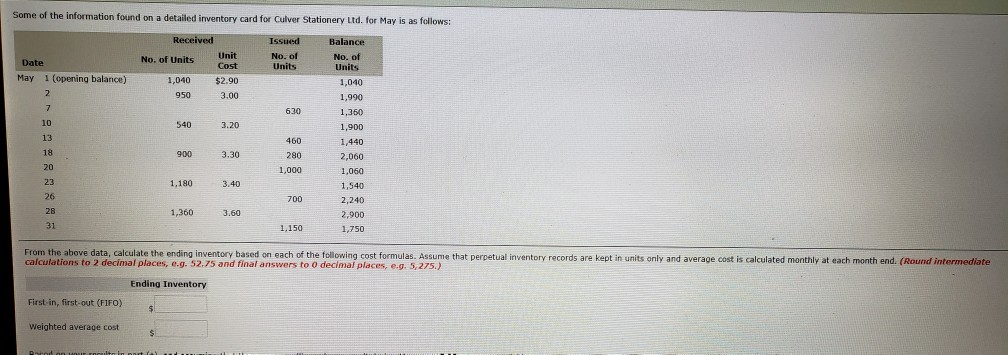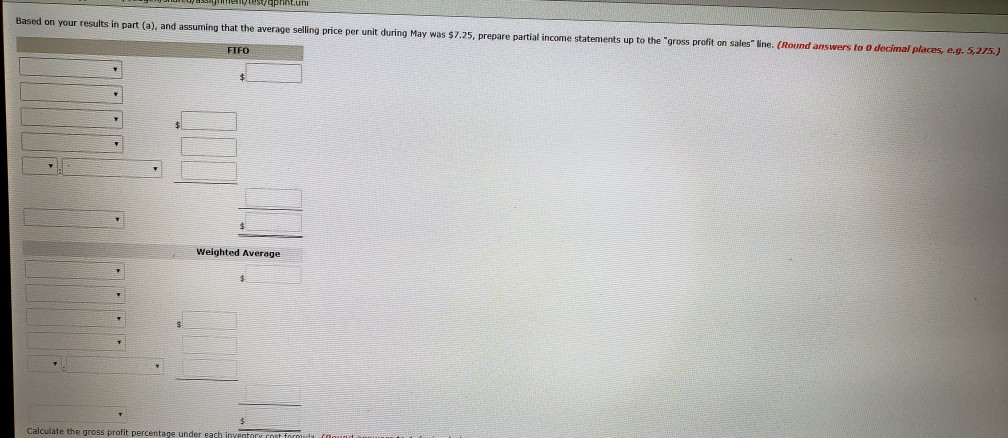Answered step by step
Verified Expert Solution
Question
1 Approved Answer
Some of the information found on a detailed inventory card for Culver Stationery Ltd. for May is as follows: Received Issued Balance Unit Cost



Some of the information found on a detailed inventory card for Culver Stationery Ltd. for May is as follows: Received Issued Balance Unit Cost No. of Units No, of Units Date No. of Units May 1 (opening balance) 1,040 $2.90 1,040 950 3.00 1,990 630 1,360 10 540 3.20 1,900 13 460 1,440 18 900 3.30 280 2,060 20 1,000 1,060 23 1,180 3.40 1,540 26 700 2,240 28 1,360 3.60 2,900 31 1,150 1,750 From the above data, calculate the ending inventory based on each of the following cost formulas. Assume that perpetual inventory records are kept in units only and average cost is calculated monthly at each month end. (Round intermediate calculations to 2 decimal places, e.g. 52.75 and final answers to 0 decimal places, e.g. 5,275.) Ending Inventory First-in, first-out (FIFO) Weighted average cost Racod on menytest/qprint.uni Based on your results in part (a), and assuming that the average selling price per unit during May was $7.25, prepare partial income statements up to the "gross profit on sales" line. (Round answers to 0 decimal places, e.g. 5,275.) FIFO Weighted Average Calculate the gross profit percentage under each inventory cost f Calculate the gross profit percentage under each inventory cost formula. (Round answwers to 1 decimal place, e.g. 527.5.) Gross Profit Percentage First-in, first-out (FIFO) Weighted average cost Assume the perpetual inventory record is kept in dollars, and costs are calculated at the time of each withdrawal. Recalculate the amounts under this revised assumption. (Round average unit costs to 4 decimal places, e.g. 52.7521 and answers to 2 decimal places, e.g. 52.75.) Ending Inventory First-in, first-out (FIFO) Moving average cost Would the ending inventory amounts under each of the two cost formulas above be the same? Some of the information found on a detailed inventory card for Culver Stationery Ltd. for May is as follows: Received Issued Balance Unit Cost No. of Units No, of Units Date No. of Units May 1 (opening balance) 1,040 $2.90 1,040 950 3.00 1,990 630 1,360 10 540 3.20 1,900 13 460 1,440 18 900 3.30 280 2,060 20 1,000 1,060 23 1,180 3.40 1,540 26 700 2,240 28 1,360 3.60 2,900 31 1,150 1,750 From the above data, calculate the ending inventory based on each of the following cost formulas. Assume that perpetual inventory records are kept in units only and average cost is calculated monthly at each month end. (Round intermediate calculations to 2 decimal places, e.g. 52.75 and final answers to 0 decimal places, e.g. 5,275.) Ending Inventory First-in, first-out (FIFO) Weighted average cost Racod on menytest/qprint.uni Based on your results in part (a), and assuming that the average selling price per unit during May was $7.25, prepare partial income statements up to the "gross profit on sales" line. (Round answers to 0 decimal places, e.g. 5,275.) FIFO Weighted Average Calculate the gross profit percentage under each inventory cost f Calculate the gross profit percentage under each inventory cost formula. (Round answwers to 1 decimal place, e.g. 527.5.) Gross Profit Percentage First-in, first-out (FIFO) Weighted average cost Assume the perpetual inventory record is kept in dollars, and costs are calculated at the time of each withdrawal. Recalculate the amounts under this revised assumption. (Round average unit costs to 4 decimal places, e.g. 52.7521 and answers to 2 decimal places, e.g. 52.75.) Ending Inventory First-in, first-out (FIFO) Moving average cost Would the ending inventory amounts under each of the two cost formulas above be the same? Some of the information found on a detailed inventory card for Culver Stationery Ltd. for May is as follows: Received Issued Balance Unit Cost No. of Units No, of Units Date No. of Units May 1 (opening balance) 1,040 $2.90 1,040 950 3.00 1,990 630 1,360 10 540 3.20 1,900 13 460 1,440 18 900 3.30 280 2,060 20 1,000 1,060 23 1,180 3.40 1,540 26 700 2,240 28 1,360 3.60 2,900 31 1,150 1,750 From the above data, calculate the ending inventory based on each of the following cost formulas. Assume that perpetual inventory records are kept in units only and average cost is calculated monthly at each month end. (Round intermediate calculations to 2 decimal places, e.g. 52.75 and final answers to 0 decimal places, e.g. 5,275.) Ending Inventory First-in, first-out (FIFO) Weighted average cost Racod on menytest/qprint.uni Based on your results in part (a), and assuming that the average selling price per unit during May was $7.25, prepare partial income statements up to the "gross profit on sales" line. (Round answers to 0 decimal places, e.g. 5,275.) FIFO Weighted Average Calculate the gross profit percentage under each inventory cost f Calculate the gross profit percentage under each inventory cost formula. (Round answwers to 1 decimal place, e.g. 527.5.) Gross Profit Percentage First-in, first-out (FIFO) Weighted average cost Assume the perpetual inventory record is kept in dollars, and costs are calculated at the time of each withdrawal. Recalculate the amounts under this revised assumption. (Round average unit costs to 4 decimal places, e.g. 52.7521 and answers to 2 decimal places, e.g. 52.75.) Ending Inventory First-in, first-out (FIFO) Moving average cost Would the ending inventory amounts under each of the two cost formulas above be the same? Some of the information found on a detailed inventory card for Culver Stationery Ltd. for May is as follows: Received Issued Balance Unit Cost No. of Units No, of Units Date No. of Units May 1 (opening balance) 1,040 $2.90 1,040 950 3.00 1,990 630 1,360 10 540 3.20 1,900 13 460 1,440 18 900 3.30 280 2,060 20 1,000 1,060 23 1,180 3.40 1,540 26 700 2,240 28 1,360 3.60 2,900 31 1,150 1,750 From the above data, calculate the ending inventory based on each of the following cost formulas. Assume that perpetual inventory records are kept in units only and average cost is calculated monthly at each month end. (Round intermediate calculations to 2 decimal places, e.g. 52.75 and final answers to 0 decimal places, e.g. 5,275.) Ending Inventory First-in, first-out (FIFO) Weighted average cost Racod on menytest/qprint.uni Based on your results in part (a), and assuming that the average selling price per unit during May was $7.25, prepare partial income statements up to the "gross profit on sales" line. (Round answers to 0 decimal places, e.g. 5,275.) FIFO Weighted Average Calculate the gross profit percentage under each inventory cost f Calculate the gross profit percentage under each inventory cost formula. (Round answwers to 1 decimal place, e.g. 527.5.) Gross Profit Percentage First-in, first-out (FIFO) Weighted average cost Assume the perpetual inventory record is kept in dollars, and costs are calculated at the time of each withdrawal. Recalculate the amounts under this revised assumption. (Round average unit costs to 4 decimal places, e.g. 52.7521 and answers to 2 decimal places, e.g. 52.75.) Ending Inventory First-in, first-out (FIFO) Moving average cost Would the ending inventory amounts under each of the two cost formulas above be the same?
Step by Step Solution
★★★★★
3.39 Rating (152 Votes )
There are 3 Steps involved in it
Step: 1
Answer Twdioh Ineome SAatement 11F0 fwrtioulars Sales Total ...
Get Instant Access to Expert-Tailored Solutions
See step-by-step solutions with expert insights and AI powered tools for academic success
Step: 2

Step: 3

Ace Your Homework with AI
Get the answers you need in no time with our AI-driven, step-by-step assistance
Get Started


